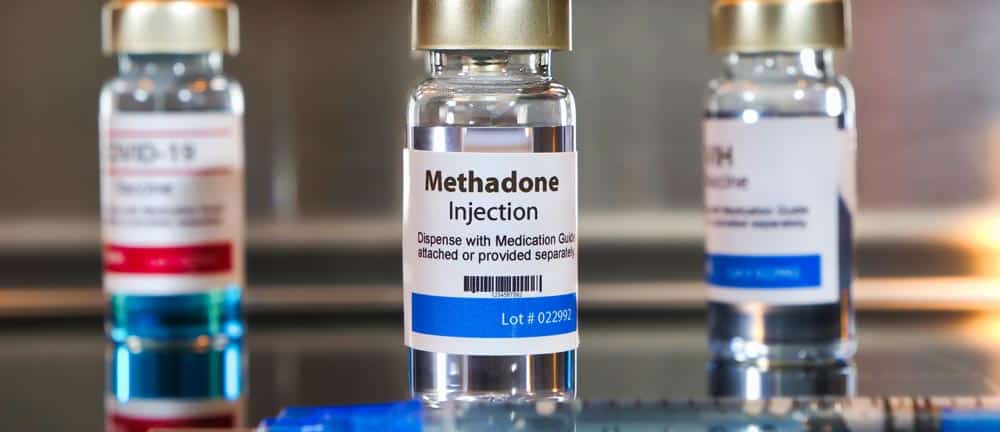Methadone
Methadone
Methadone is a medication that patients take while in treatment for drug addiction. This medicine helps lessen the pain that occurs during the withdrawal process. The medication also works to block the effects of opiate drugs, including cravings.
What is Methadone?
Methadone is a synthetic opioid drug that works to relieve pain. Its effects are similar to those of morphine or other narcotics used for pain reduction. Methadone works much in the same way that morphine does, but without the feelings of pleasure or “high” that many opiates provide.
Methadone is often used during medication-assisted therapy (MAT) during addiction treatment. It is sometimes called replacement therapy because methadone takes the place of the addictive drug without the cravings and withdrawal.

Uses of Methadone
Treatment (MMT)
In 2017, over 70,000 Americans died from drug overdose. Sixty-eight percent of those deaths were the result of prescription or illegal opioid use.
According to the Center for Disease Control, the death rate linked to an overdose of prescription opioid drugs (including natural and synthetic drugs plus methadone) increased by 300% between 1999 and 2014, going from 3,442 people in 1999 to 14,838 in 2014.
The rate of deaths due to methadone overdose fatalities increased by 600% from 784 in 1999 to 5,406 in 2006. These numbers remained stable in 2007, but then overdose deaths from methadone decreased 39% (3,400 people) in 2014.
Although it appears that methadone overdose deaths have declined, this medication still accounts for almost one in every four opioid prescription overdose deaths.
Methadone is used not only in medication-assisted therapy but is also widely used to relieve pain. Close to 4 million methadone prescriptions are written yearly to treat pain. In addition, 1.5 million people over the age of 12 have used methadone for non-medical or recreational purposes at least once.
Pros and Cons of Methadone
Benefits of Methadone
MAT with methadone will help a person battle drug cravings and deal with painful withdrawal symptoms.
A dramatic decrease for risk of infection for those who were injecting opioids
Criminal activity will be reduced, as illegal drugs are no longer being used
Quality of life will improve
Methadone provides a better chance for successful, long-term recovery
Without the distractions of cravings and withdrawal pain, there is more interest in participating fully in recovery treatment programs
Negative Side of Methadone
If someone is taking methadone to help in their recovery from substance use, adding on other drugs or alcohol can cause serious side effects. For example, mixing methadone with alcohol or sedatives can lead to slowed breathing, loss of consciousness, coma, or perhaps even death.
Using methadone for the long term can cause changes to take place in the brain that may affect learning and memory.
•Sedation
•Decreased reactions times
•Drooping eyelids
•Lowered blood pressure
•Sweating
•Slowed or shallow breathing
•Decreased attention span
•Dry mouth
•Decreased sensitivity to light
•Constipation
•Change in heartbeat rates
•Sleepiness
•Weak muscles
•Itchy skin
Risks of Methadone Use
Dangers Posed By Methadone Use
It can cause the following to occur:
•Severe breathing difficulties
•Coma
•Reduced blood pressure and heart rate
•Excess fluid in the lungs
•Death
•Death can also result when methadone is taken with other drugs, such as cocaine, Valium, or Xanax.
Methadone does not react well with certain other medications, especially sedatives that treat seizures, insomnia, or anxiety.
Health Risks
When used over a lengthy period, methadone can lead to lung or respiratory problems. The drugs place you at risk for serious side effects if you have any of the following health issues:
•Heart disease or rhythm disorders
•Electrolyte imbalance
•Lung disease or breathing issues
•Head injury, brain tumor, or seizures
•Liver or kidney disease
•Urination problems
•Gallbladder or pancreas issues
•Thyroid problems
•A condition that requires taking sedatives
You can also become addicted to methadone. If taken for pain, your brain may come to rely upon you taking it to relieve discomfort.
Methadone Withdrawal
Symptoms
Methadone withdrawal might include some of the following flu-like symptoms:
•Feeling tired
•Anxiety
•Restlessness
•Perspiration
•Watery discharge from the eyes
•Runny nose
•Excessive yawning
•Insomnia
How much and how you should take methadone, and in which form, will depend on the following:
•Your age
•What condition the medication is treating
•The severity of the condition
•Any other medical issues you may have
•How the first dose affects you
•The dosages come in either 5 to 10 mg tablets.
•For short-term pain that is moderate to severe, the adult dosage will usually begin at 2.5 mg every 8-12 hours. The dose can then be increased slowly over the next five days.
•For help with withdrawal from opioids, adults are typically prescribed 20-30 mg of methadone, with an additional 5-10 mg provided after 2-4 hours, if needed.
•When a maintenance dose of methadone is required for an addiction to opioids, adults are given 80-120 mg per day.
•All of the above dosages are different for children who are 17 years old and under and for adults who are over the age of 64.
Myths and Misconceptions
- Journal of Evidence-based Social Work. Adderall abuse on college campuses: a comprehensive literature review.
- The New York Times Magazine. Generation Adderall.
- United States Drug Enforcement Administration. Drug Scheduling.
- Official Site: MYDAYIS.
- American Journal of Public Health. America’s First Amphetamine Epidemic 1929–1971 A Quantitative and Qualitative Retrospective With Implications for the Present.
- Addiction Behaviors. Do college students improve their grades by using prescription stimulants nonmedically?
- SAMHSA. The Dawn Report.
- Drug Enforcement Administration. Diversion Control Division.
- TOXNET Toxicology Data Network. Amphetamine.
- CNS Drugs. Overdose of drugs for attention-deficit hyperactivity disorder: clinical presentation, mechanisms of toxicity, and management.
- SAMHSA/CSAT. Treatment for Stimulant Use Disorders.
- National Institute on Drug Abuse for Teens. 5 Myths about ADHD Drugs.
Methadone is Highly Effective for Drug Detox
Although there are some drawbacks associated with the use of methadone in heroin and opioid addiction treatment, the positives tend to far outweigh the negatives. Methadone is a highly effective, FDA-approved medication used to treat opioid use disorders.
Considering all the causes of death among people who are receiving methadone for a substance disorder, it was found that one-third of them were less likely to die than those who were not being treated with methadone. Aside from saving many lives in the past, this medication has the potential to save many more lives in the future.

We Work With Most Major Insurance Providers
The Safe Harbor Treatment Center’s Admissions Team works to ensure that we can help as many people struggling with substance abuse. Verify your benefits now and we’ll get back to you right away.
Receive the highest level of care available at Safe Harbor. We are here to answer your call or fill out our confidential contact form to get started.

